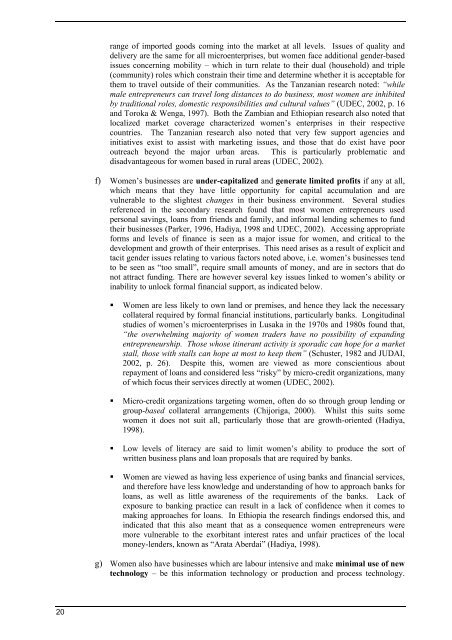The Challenges of Growing Small Businesses - International Labour ...
The Challenges of Growing Small Businesses - International Labour ...
The Challenges of Growing Small Businesses - International Labour ...
Create successful ePaper yourself
Turn your PDF publications into a flip-book with our unique Google optimized e-Paper software.
ange <strong>of</strong> imported goods coming into the market at all levels. Issues <strong>of</strong> quality and<br />
delivery are the same for all microenterprises, but women face additional gender-based<br />
issues concerning mobility – which in turn relate to their dual (household) and triple<br />
(community) roles which constrain their time and determine whether it is acceptable for<br />
them to travel outside <strong>of</strong> their communities. As the Tanzanian research noted: “while<br />
male entrepreneurs can travel long distances to do business, most women are inhibited<br />
by traditional roles, domestic responsibilities and cultural values” (UDEC, 2002, p. 16<br />
and Toroka & Wenga, 1997). Both the Zambian and Ethiopian research also noted that<br />
localized market coverage characterized women’s enterprises in their respective<br />
countries. <strong>The</strong> Tanzanian research also noted that very few support agencies and<br />
initiatives exist to assist with marketing issues, and those that do exist have poor<br />
outreach beyond the major urban areas. This is particularly problematic and<br />
disadvantageous for women based in rural areas (UDEC, 2002).<br />
f) Women’s businesses are under-capitalized and generate limited pr<strong>of</strong>its if any at all,<br />
which means that they have little opportunity for capital accumulation and are<br />
vulnerable to the slightest changes in their business environment. Several studies<br />
referenced in the secondary research found that most women entrepreneurs used<br />
personal savings, loans from friends and family, and informal lending schemes to fund<br />
their businesses (Parker, 1996, Hadiya, 1998 and UDEC, 2002). Accessing appropriate<br />
forms and levels <strong>of</strong> finance is seen as a major issue for women, and critical to the<br />
development and growth <strong>of</strong> their enterprises. This need arises as a result <strong>of</strong> explicit and<br />
tacit gender issues relating to various factors noted above, i.e. women’s businesses tend<br />
to be seen as “too small”, require small amounts <strong>of</strong> money, and are in sectors that do<br />
not attract funding. <strong>The</strong>re are however several key issues linked to women’s ability or<br />
inability to unlock formal financial support, as indicated below.<br />
• Women are less likely to own land or premises, and hence they lack the necessary<br />
collateral required by formal financial institutions, particularly banks. Longitudinal<br />
studies <strong>of</strong> women’s microenterprises in Lusaka in the 1970s and 1980s found that,<br />
“the overwhelming majority <strong>of</strong> women traders have no possibility <strong>of</strong> expanding<br />
entrepreneurship. Those whose itinerant activity is sporadic can hope for a market<br />
stall, those with stalls can hope at most to keep them” (Schuster, 1982 and JUDAI,<br />
2002, p. 26). Despite this, women are viewed as more conscientious about<br />
repayment <strong>of</strong> loans and considered less “risky” by micro-credit organizations, many<br />
<strong>of</strong> which focus their services directly at women (UDEC, 2002).<br />
• Micro-credit organizations targeting women, <strong>of</strong>ten do so through group lending or<br />
group-based collateral arrangements (Chijoriga, 2000). Whilst this suits some<br />
women it does not suit all, particularly those that are growth-oriented (Hadiya,<br />
1998).<br />
• Low levels <strong>of</strong> literacy are said to limit women’s ability to produce the sort <strong>of</strong><br />
written business plans and loan proposals that are required by banks.<br />
• Women are viewed as having less experience <strong>of</strong> using banks and financial services,<br />
and therefore have less knowledge and understanding <strong>of</strong> how to approach banks for<br />
loans, as well as little awareness <strong>of</strong> the requirements <strong>of</strong> the banks. Lack <strong>of</strong><br />
exposure to banking practice can result in a lack <strong>of</strong> confidence when it comes to<br />
making approaches for loans. In Ethiopia the research findings endorsed this, and<br />
indicated that this also meant that as a consequence women entrepreneurs were<br />
more vulnerable to the exorbitant interest rates and unfair practices <strong>of</strong> the local<br />
money-lenders, known as “Arata Aberdai” (Hadiya, 1998).<br />
g) Women also have businesses which are labour intensive and make minimal use <strong>of</strong> new<br />
technology – be this information technology or production and process technology.<br />
20
















